| Previous | Contents | Index |
The following sections describe the debugger windows, menus, views, and
other features of the OpenVMS Debugger HP DECwindows Motif for OpenVMS interface.
8.2.1 Default Window Configuration
By default, the debugger starts up in the main window, as shown in Figure 8-1.
When you start the debugger as explained in Section 9.1, the source view is initially empty. Figure 8-1 shows the source view after a program has been brought under debugger control (by directing the debugger to run a specific image, in this example, EIGHTQUEENS).
You can customize the startup configuration to your preference as described in Section 10.10.1.
Figure 8-1 Debugger Main Window
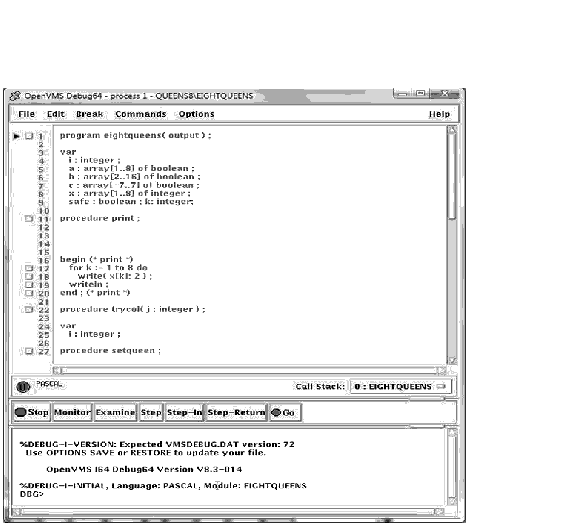
The main window (see Figure 8-1) includes:
If the debugger is running on an Alpha or Integrity server processor,
the name of the debugger is "OpenVMS Debug64."
8.2.2.1 Title Bar
The title bar, at the top of the main window, displays (by default) the
name of the debugger, the name of the program being debugged, and the
name of the source code module that is currently displayed in the
source view.
8.2.2.2 Source View
The source view shows the following:
For more information about displaying source code, see Section 8.2.2.3
and Section 10.1.
8.2.2.3 Menus on Main Window
Figure 8-2 and Table 8-1 describe the menus on the main window.
Figure 8-2 Menus on Main Window
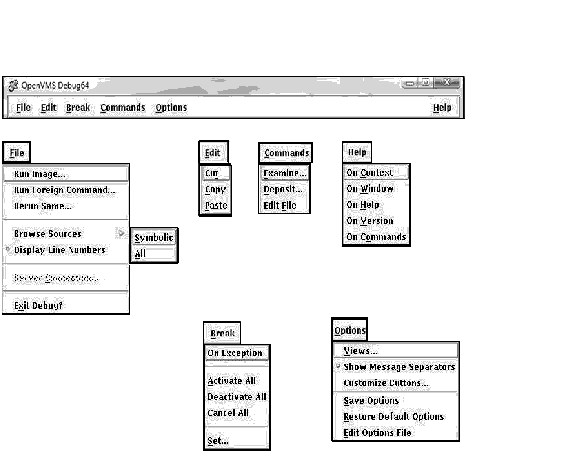
| Menu | Item | Description |
|---|---|---|
| File | Run Image... | Bring a program under debugger control by specifying an executable image. |
| Run Foreign Command... | Bring a program under debugger control by specifying a symbol for a foreign command. | |
| Rerun Same... | Rerun the same program under debugger control. | |
| Browse Sources |
Display the source code in any module of your program. Set breakpoints
on routines.
|
|
| Display Line Numbers | Display or hide line numbers in the source view. | |
| Server Connection... | (Client/Server mode) Specify the network binding string of the server for connection. | |
| Exit Debug? | End the debugging session, terminating the debugger. | |
| Edit | Cut | Cut selected text and copy it to the clipboard. You can cut text only from fields or regions that accept input (although, in most cases, Cut copies the selected text to the clipboard). |
| Copy | Copy selected text from the window to the clipboard without deleting the text. | |
| Paste | Paste text from the clipboard to a text-entry field or region. | |
| Break | On Exception | Break on any exception signaled during program execution. |
| Activate All | Activate any previously set breakpoints. | |
| Deactivate All | Deactivate any previously set breakpoints. | |
| Cancel All | Remove all breakpoints from the debugger's breakpoint list and from the breakpoint view. | |
| Set... | Set a new breakpoint, optionally associated with a particular condition or action, at a specified location. | |
| Commands | Examine... | Examine the current value of a variable or expression. The output value may be typecast or changed in radix. |
| Deposit... | Deposit a value to a variable. The input value may be changed in radix. | |
| Edit File | Edit the source code of your file in the debugger's editor. | |
| Options | Views... |
Display one or more of the following:
Breakpoint view |
| Track Language Changes | Notify you if the debugger enters a module that is written in a language different from the previously executed module. | |
| Show Message Separators | Display a dotted line between each command and message displayed by the debugger. | |
| Customize Buttons... | Modify, add, remove, or resequence a push button in the push button view and the associated debugger command. | |
| Save Options | Save the current settings of all HP DECwindows Motif for OpenVMS features of the debugger that you can customize interactively, such as the configuration of windows and views, and push button definitions. This preserves the current debugger configuration for the next time you run the debugger. | |
| Restore Default Options | Copy the system default debugger resource file DECW$SYSTEM_DEFAULTS:VMSDEBUG.DAT to the user-specific resource file DECW$USER_DEFAULTS:VMSDEBUG.DAT. The default options take effect when you next start the debugger. | |
| Edit Options File | Load and display the user-specific resource file DECW$USER_DEFAULTS:VMSDEBUG.DAT in the debug editor for review and modification. | |
| Help | On Context | Enable the display of context-sensitive online help. |
| On Window | Display information about the debugger. | |
| On Help | Display information about the online help system. | |
| On Version | Display information about this version of the debugger. | |
| On Commands | Display information about debugger commands. |
| Register Type | Alpha Displays | Integrity Server Displays |
|---|---|---|
| Call Frame | R0, R25, R26, R27, FP, SP, F0, F1, PC, PS, FPCR, SFPCR | PC, CFM, BSP, BSPSTORE, PFS, RP, UNAT, GP, SP, TP, AI |
| General Purpose | R0-R28, FP, SP, R31 | PC, GP, R2-R11, SP, TP, R14-R24, AI, R26-R127 |
| Floating Point | F0-F31 | F2 - F127 |
The Call Stack menu, between the source view and the push button view,
shows the name of the routine whose source code is displayed in the
source view. This menu lists the sequence of routine calls currently on
the stack and lets you set the scope of source code display and symbol
searches to any routine on the stack (see Section 10.6.2).
8.2.2.5 Push Button View
Figure 8-3 and Table 8-3 describe the default push buttons in the main window. You can modify, add, remove, and resequence buttons and their associated commands as explained in Section 10.10.3.
Figure 8-3 Default Buttons in the Push Button View

| Button | Description |
|---|---|
| Stop | Interrupt program execution or a debugger operation without ending the debugging session. |
| Go | Start or resume execution from the current program location. |
| STEP | Execute the program one step unit of execution. By default, this is one executable line of source code. |
| S/in | When execution is suspended at a routine call statement, move execution into the called routine just past the start of the routine. This is the same behavior as STEP if not at a routine call statement. |
| S/ret | Execute the program directly to the end of the current routine. |
| S/call | Execute the program directly to the next Call or Return instruction. |
| EX | Display, in the command view, the current value of a variable whose name you have selected in a window. |
| E/az | Display, in the command view, the current value of a variable whose name you have selected in a window. The variable is interpreted as a zero-terminated ASCII string. |
| E/ac | Display, in the command view, the current value of a variable whose name you have selected in a window. The variable is interpreted as a counted ASCII string preceded by a one-byte count field that contains the length of the string. |
| EVAL | Display, in the command view, the value of a language expression in the current language (by default, the language of the module containing the main program). |
| MON | Display, in the monitor view, a variable name that you have selected in a window and the current value of that variable. Whenever the debugger regains control from your program, it automatically checks the value and updates the displayed value accordingly. |
The command view, located directly under the push button view in the main window, accepts typed command input on the command line (see Section 8.3), and displays debugger output other than that displayed in the optional views. Examples of such output are:
You can clear the entire command view, leaving only the current command-line prompt, by choosing Clear Command Window from the pop-up menu.
You can clear the current command line by choosing Clear Command Line
from the pop-up menu.
8.2.3 Optional Views Window
Table 8-4 lists the optional views. They are accessible by choosing Views... from the Options menu on the main window.
| View | Description |
|---|---|
| Breakpoint view | List all breakpoints that are currently set and identify those which are activated, deactivated, or qualified as conditional breakpoints. The breakpoint view also allows you to modify the state of each breakpoint. |
| Monitor view | List variables whose values you want to monitor as your program executes. The debugger updates the values whenever it regains control from your program (for example, after a step or at a breakpoint). Alternatively, you can set a watchpoint, causing execution to stop whenever a particular variable has been modified. You can also change the values of variables. |
| Instruction view | Display the decoded instruction stream of your program and allow you to set breakpoints on instructions. By default, the debugger displays the corresponding memory addresses and source-code line numbers to the left of the instructions. You can choose to suppress these. |
| Register view | Display the current contents of all machine registers. The debugger updates the values whenever it regains control from your program. The register view also lets you change the values in registers. |
| Tasking view | List all the existing (nonterminated) tasks of a tasking program. Provides information about each task and allows you to modify the state of each task. |
Figure 8-5 shows a possible configuration of the breakpoint view, monitor view, and register view, as a result of the selections in the View menu in Figure 8-4.
Figure 8-6 shows the instruction view, which is a separate window so that you can position it where most convenient. Figure 8-7 shows the tasking view.
Note that the registers and instructions displayed are system-specific. Figure 8-5 and Figure 8-6 show Integrity server-specific registers and instructions.
You can move and resize all windows. You can also save a particular configuration of the windows and views so that it is set up automatically when you restart the debugger (see Section 10.10.1).
Figure 8-4 Debugger Main Window and the Optional Views Window
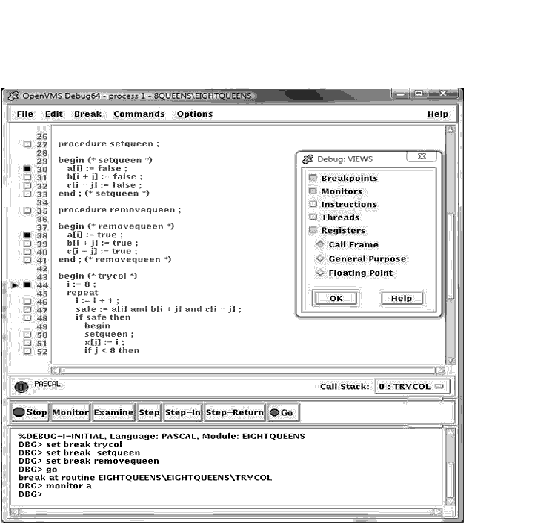
Figure 8-5 Monitor, Breakpoint, and Register Views
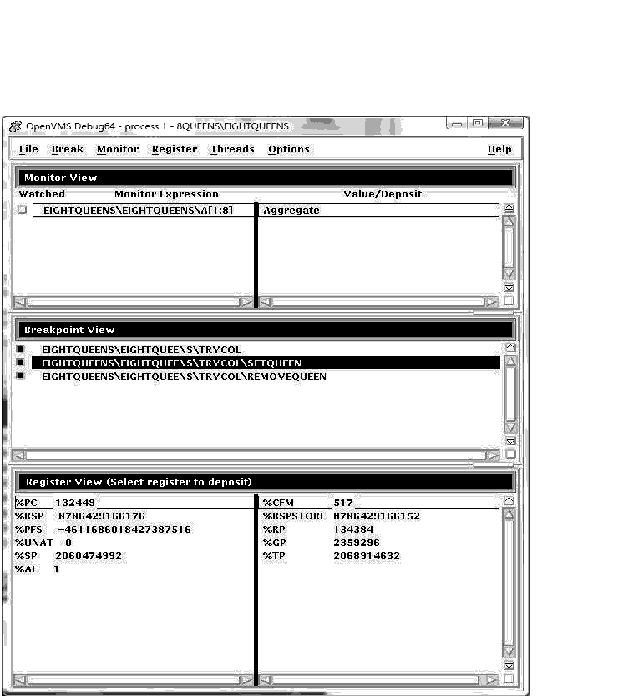
Figure 8-6 Instruction View
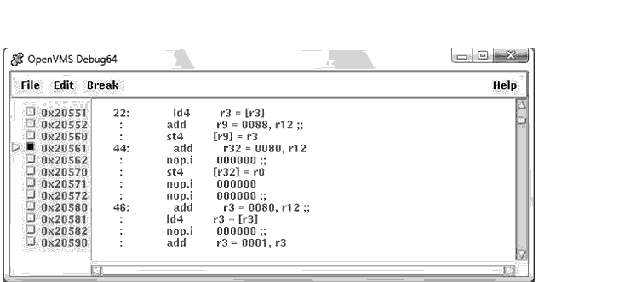
Figure 8-7 Thread View

Figure 8-8 and Table 8-5 describe the menus on the optional views window.
Figure 8-8 Menus on Optional Views Window
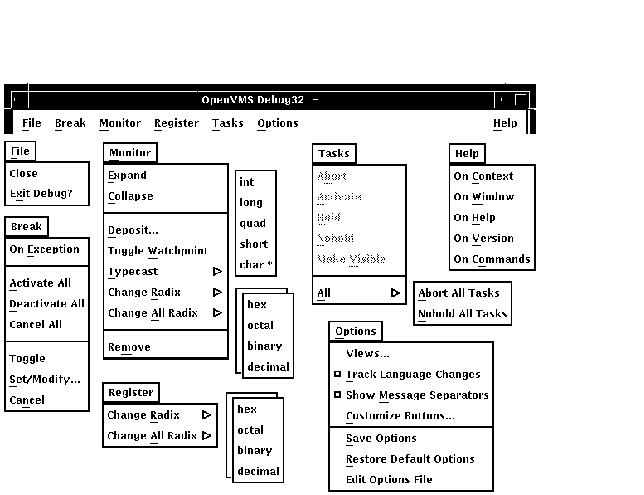
| Menu | Item | Description |
|---|---|---|
| File | Close | Close the optional views window. |
| Exit Debug? | End the debugging session, terminating the debugger. | |
| Break | On Exception | Break on any exception signaled during program execution. |
| Activate All | Activate any previously set breakpoints. | |
| Deactivate All | Deactivate any previously set breakpoints. | |
| Cancel All | Remove all breakpoints from the debugger's breakpoint list and from the breakpoint view. | |
| Toggle | Toggle a breakpoint. | |
| Set/Modify... | Set a new breakpoint, optionally associated with a particular condition or action, at a specified location. | |
| Cancel | Cancel (delete) an individual breakpoint. | |
| Monitor | Expand | Expand monitor view output to include the values of component parts of a selected item as well as the aggregate value. |
| Collapse | Collapse the monitor view output to show only the aggregate value of a selected item, instead of the values of each component part. | |
| Deposit... | Change the value of a monitored element. | |
| Toggle Watchpoint | Toggle a selected watchpoint. | |
| Typecast | Use the submenu to typecast output for a selected variable to int, long, quad, short, or char*. | |
| Change Radix | Use the submenu to change the output radix for a selected variable to hex, octal, binary, or decimal. | |
| Change All Radix | Use the submenu to change the output radix for all subsequent monitored elements to hex, octal, binary, or decimal. | |
| Remove | Remove an element from the monitor view. | |
| Register | Change Radix | Use the submenu to change radix for selected register to hex, octal, binary, or decimal. |
| Change All Radix | Use the submenu to change radix for all registers to hex, octal, binary, or decimal. | |
| Tasks | Abort | Request that the selected task be terminated at the next allowed opportunity. |
| Activate | Make the selected task the active task. | |
| Hold | Place the selected task on hold. | |
| Nohold | Release the selected task from hold. | |
| Make Visible | Make the selected task the visible task. | |
| All | Use the submenu to abort all tasks or release all tasks from hold. | |
| Options | Views... |
Display one or more of the following:
Breakpoint view |
| Customize Buttons... | Modify, add, remove, or resequence a push button in the push button view and the associated debugger command. | |
| Save Options | Save the current settings of all HP DECwindows Motif for OpenVMS features of the debugger that you can customize interactively, such as the configuration of windows and views, and push button definitions. This preserves your current debugger configuration for the next time you run the debugger. | |
| Restore Default Options | Copy the system default debugger resource file DECW$SYSTEM_DEFAULTS:VMSDEBUG.DAT to the user-specific resource file DECW$USER_DEFAULTS:VMSDEBUG.DAT. The default options take effect when you next start the debugger. | |
| Edit Options File | Load and display the user-specific resource file DECW$USER_DEFAULTS:VMSDEBUG.DAT in the debug editor for review and modification. | |
| Help | On Context | Enable the display of context-sensitive online help. |
| On Window | Display information about the debugger. | |
| On Help | Display information about the online help system. | |
| On Version | Display information about this version of the debugger. | |
| On Commands | Display information about debugger commands. |
| Previous | Next | Contents | Index |